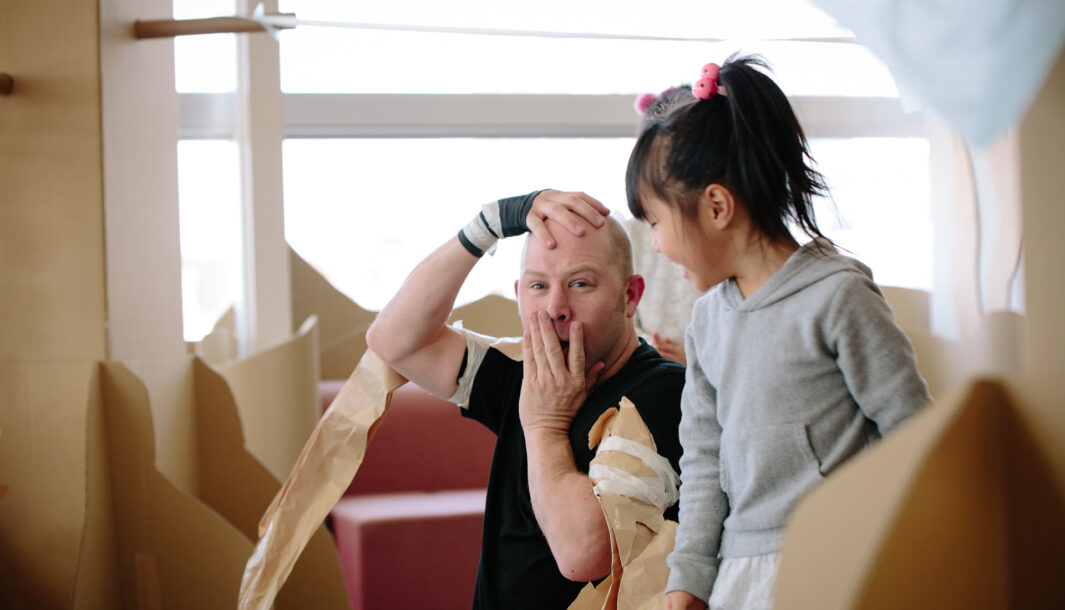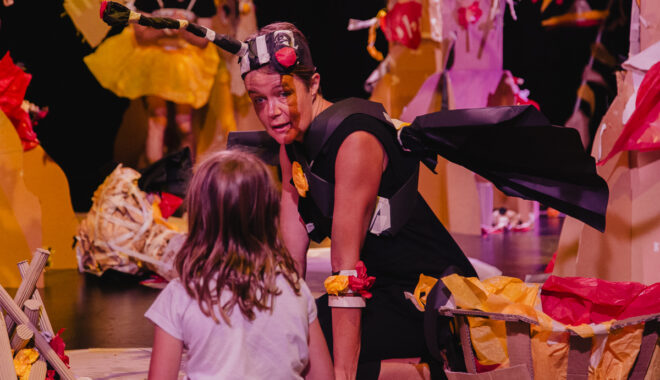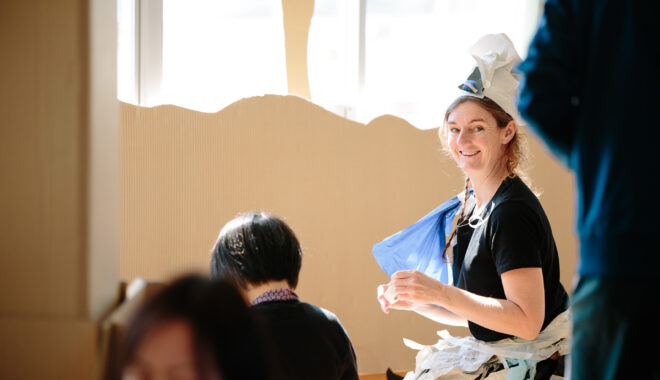21 Jun 2021 Artistic Reflections
Reflections on Paper Planet and access

By Mischa Long
I have had the privilege of working for Polyglot for 25 years, and in that time I have also had a concurrent path as an art teacher in the specialist school system. These two worlds have fed into each other for years. My experiences with shows such as Paper Planet and We Built This City have given me ideas on how to better engage children with sensory tasks ,and my work in the specialist schools makes me better able to cater to neurodivergent participants of Polyglot shows. One of the things I have always loved about Polyglot is the determination the company has to give everyone a chance to be involved, to explore and play in our worlds. There are countless examples of the times I have seen people hesitant to enter a space leaving with huge smiles. This can be especially true of children and adults with disabilities, and their families or carers. There have been lots of barriers to the engagement of these kids in the past that are thankfully now being challenged.
One of the seeds for this new adaptation of Paper Planet was a show that we did in Philadelphia (USA) in 2016, where we created a sensory friendly version for a group of ASD young adults. Their educators were concerned that the show might be challenging for them, so we met and talked and reassured them. The changes we made were simple yet profound: minimising the noise in the space, looking for more opportunities to create sensory activities, and perhaps most crucially for the teachers (and most natural to us) creating a space where any response was welcomed. Someone wants to vocalise loudly? Fine. They want to rip up all that paper? Fine. They want to sit out and watch? That’s also fine. It sounds simple but, as the staff reiterated to us, this acceptance of behaviours that might not be as welcomed in a more traditional theatre setting was liberating for their students and allowed the staff to relax rather than trying to keep these behaviours ‘in check’.
Something I have observed over the years is the desperate need for shows such as this, that adapt to the sensory needs of the participants, that allow for responses that may be unusual or surprising, that allow the children to just be. Or to put it another way, to adapt our world to their needs rather than trying to force them into ours all the time. (I have heard and read variations on this idea over the years from a number of disability advocates.)
So many of the shows I was seeing presented in a specialist school setting were not designed with these children in mind. They were perfectly fine for a mainstream setting, but were unable to adapt to this one. Loud noises, fast or unexpected movement, storylines that did not engage the students, the need for students to sit in one place for 45 minutes. In a regular theatre setting these expectations can be heightened further, a sudden darkening of the lights distressing the child, too much activity on the stage. The result can be sensory overload, attempts at regulation that may be “disruptive” to other audience members or performers, the child and parent/carer feeling that they have to leave. The result of this is a reluctance to take kids to shows or experiences that may be challenging. This means that a whole cadre of individuals are missing out on experiences and connections, missing out on their right to participate in the arts as part of the creative citizenry. The phrase that comes to mind here is, ‘who is NOT in the room?’ or, ‘which participants are not being welcomed into our space?’
This is the core of why Paper Planet works so well in this setting. It is extremely adaptable in its set up, we can have caves and cubbies, nests full of paper, things to hide under, items to toss in the air, hang from trees, to scrunch. At one session we had a little boy who just wanted to knock our corrugated card ‘fence’ over. The teachers were constantly trying to stop him until we were able to say, “That’s fine! Let him go, we can fix it easily” and what may have been a source of stress for the staff became a more playful engagement. We even played at trying to fix it while he knocked it over. He had a blast.
Another one of my favourite interactions within the space is watching the children in wheelchairs be involved and ensconced in the paper world. Showers of paper snow, being wrapped in vines, and often making amazing costume pieces for them and their chairs. The kids that sometimes just sit and watch become central figures. A wheelchair user leaving the forest with full size paper wings attached is an awesome sight.
And so recently, after being involved in the development of this version of Paper Planet and getting to perform at a number of schools, I finally had the chance to bring it to my school and see it at work from the other side. The first thing I need to point out is that if the show had not come to the school, most of my students would never have experienced it. For all the reasons above, parents and families can be very cautious about entering new spaces, particularly if there are also language barriers or travel considerations. The effort to get there may be too much for many, a totally understandable response. By bringing the show into the school we are giving them an offering they may never receive otherwise. This is profound in terms of the notion of inclusivity and also the function of art in general, which by its nature should seek to engage as many people as possible.
As the students entered, I watched them with my preconceptions of them as their teacher colouring my view of what might happen. This will be true of all teachers and staff, we work with them in so many settings and we are conditioned to their behaviours, and how to manage them. What became apparent was how many of those preconceptions were misplaced. I watched first hand as students responded in ways that I did not expect, interacted in ways I hadn’t seen before, explored and engaged with this cardboard forest that had taken over their gym. It was magical. I felt moved to tears on every day of the installation, by small things that had big significance. Watching a student who has difficulty in new settings and was crouched against a wall being slowly engaged by a performer, tearing and throwing little bits of snow, talking gently, until he joins in and then enters the space to explore further… This was huge for my understanding of what can happen in the forest.
There were many examples of students who can often find it hard to sit and focus for lengthy periods, actually sitting and playing with the paper, watching a performer, swaying to the music, calmly and with real engagement. These were wonderful. The performers in this version had ukuleles and a guitar, and the gentle, live music had a lovely effect on some students. The focus they exhibited watching the players, or reaching out to strum the guitar or singing along – it was simple but meaningful joy. I watched again and again as expectations were dismissed, discoveries were made and the students surprised and delighted the staff. That feeling of the staff relaxing around the students and just letting them go? I saw it and felt it myself for the first time and I was struck by how powerful and transformative this space can be.
A large, vital part of this of course is the Polyglot performers. Firstly because they are universally empathetic, responsive and open, and also because they don’t know what to expect from the students and therefore have no preconceptions. They don’t know the students and this can be a real benefit to making breakthroughs big and small. It is when staff comment to them about how significant a certain action or response is that they understand. I have been there many times as a performer, now I was watching it as a teacher.
That week of Paper Planet drove home to me just how much potential there is in this piece, and in Polyglot’s offer to students outside of the mainstream setting. I was already a champion of the piece as a Polyglot artist. Now having seen it weave it’s magic from a teachers perspective, I am a firm believer that this show is a wonderful opportunity for these kids, and their families and the staff that work with them, to experience a world where so much is possible, where they are welcomed as they are, and where they can defy expectations, all with paper and masking tape and imagination. I use the word magic a lot when I describe Paper Planet, and that is because it is. A make-believe world that can affect your view of the real one in a positive way and offer creativity to those who most need it but find it hard to access? That is magical.
The Victorian Department of Education and Training’s Strategic Partnerships Program is supporting Polyglot to deliver Paper Planet workshops in metropolitan and regional specialist schools.







